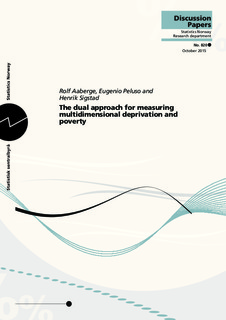| dc.contributor.author | Aaberge, Rolf | |
| dc.contributor.author | Peluso, Eugenio | |
| dc.contributor.author | Sigstad, Henrik | |
| dc.coverage.spatial | Norge | nb_NO |
| dc.date.accessioned | 2019-07-22T12:25:24Z | |
| dc.date.available | 2019-07-22T12:25:24Z | |
| dc.date.issued | 2015-10 | |
| dc.identifier.issn | 1892-753X | |
| dc.identifier.uri | http://hdl.handle.net/11250/2606178 | |
| dc.description.abstract | This paper is concerned with the problem of ranking and quantifying the extent of deprivation exhibited by multidimensional distributions, where the multiple attributes in which an individual can be deprived are represented by dichotomized variables. To this end we first aggregate deprivation for each individual into a distribution of deprivation count, representing the number of dimensions for which the population suffer from deprivation. Next, by drawing on the dual social evaluation framework that originates from Yaari (1987, 1988) social evaluation functions are used to construct summary measures of deprivation. Moreover, the measures of deprivation are proven to admit decomposition into the mean and the dispersion of the distribution of multiple deprivations. Two alternative criteria of second-degree count distribution dominance are shown to divide the family of dual measures of deprivation into two separate subfamilies, which differ with regard to whether concern is turned towards those people suffering from deprivation on all dimensions or those suffering from at least one dimension. To provide a normative justification of the dominance criteria we introduce alternative principles of association rearrangements, where the mean deprivation is assumed to be kept fixed. An empirical application based on data for 26 European countries illustrates the usefulness of the proposed framework and shows how different ethical views lead to different results. | nb_NO |
| dc.language.iso | eng | nb_NO |
| dc.publisher | Statistisk sentralbyrå | nb_NO |
| dc.relation.ispartofseries | Discussion papers;820 | |
| dc.subject | Multidimensional deprivation | nb_NO |
| dc.subject | counting approach | nb_NO |
| dc.subject | partial orderings | nb_NO |
| dc.subject | dual measures of deprivation | nb_NO |
| dc.subject | principles of mean preserving association rearrangements. | nb_NO |
| dc.title | The dual approach for measuring multidimensional deprivation and poverty | nb_NO |
| dc.type | Working paper | nb_NO |
| dc.description.version | publishedVersion | nb_NO |
| dc.source.pagenumber | 39 s. | nb_NO |
